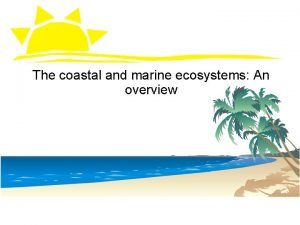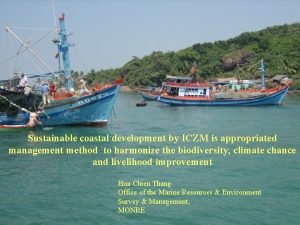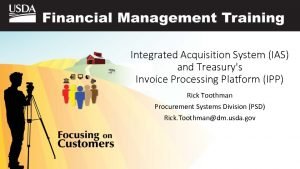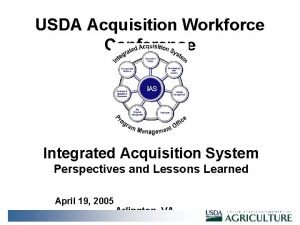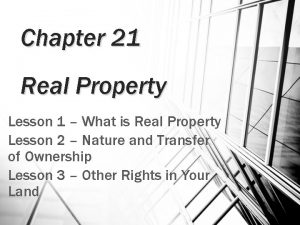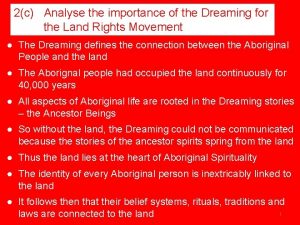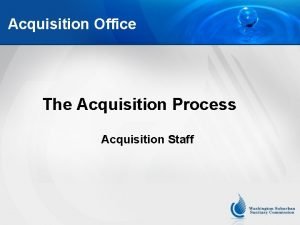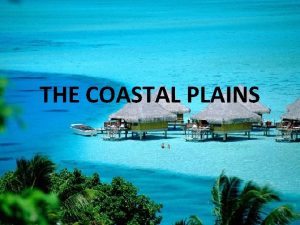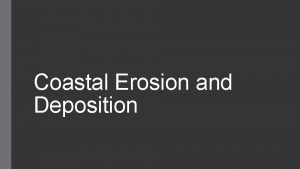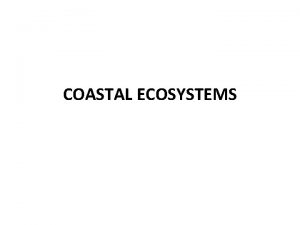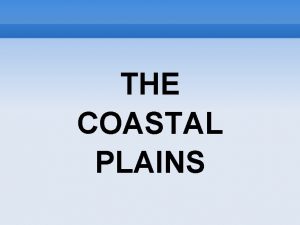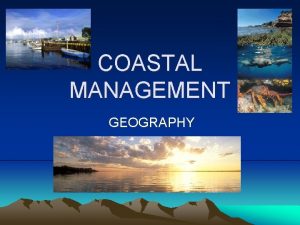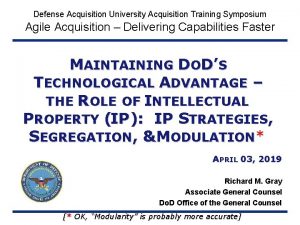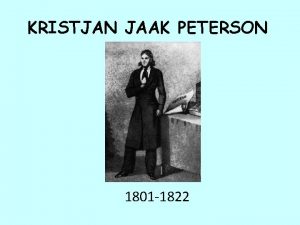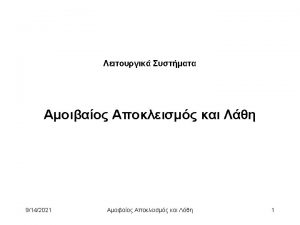Integrated Coastal Protection Land Rights Acquisition David Peterson



















- Slides: 19

Integrated Coastal Protection Land Rights Acquisition David Peterson General Counsel ALBL 78 th Annual Meeting December 5, 2018 committed to our coast

Integrated Coastal Protection • Comprehensive Integrated Coastal Protection must proceed in a manner that recognizes the powers and duties of the State and political subdivisions to fund and manage activities that are consistent with the goals of a comprehensive integrated coastal protection plan. La. R. S. 49: 214. 1 • The legislature has further recognized that a substantial majority of the coastal lands in Louisiana are privately owned and that a significant portion of the projects funded through the Coastal Protection and Restoration Fund either will occur on or in some manner affect private property. Projects funded with public dollars to not create rights in public. La. R. S. 49: 214. 5. 5 • The full police power of the state shall be exercised to address the loss and devastation to the state and individuals arising from hurricanes, storm surges and flooding and to address the rapid, ongoing, and catastrophic loss of coastal Louisiana in order to devote the maximum resources of the state to meet these immediate and compelling public necessities of integrated coastal protection. La R. S. 49: 214. 5. 6

CPRA Jurisdiction Geographic Jurisdiction – La. R. S. 49: 214. 2(3) coastal area – “the Louisiana Coastal Zone and contiguous areas subject to storm or tidal surge and the area comprising the Louisiana Coastal Ecosystem as defined in Section 7001 of 110 Public Law 114 (WRDA 2007)” Section 7001 of WRDA 2007 - Louisiana Coastal Ecosystem is defined as “the coastal area of Louisiana from the Sabine River on the west to the Pearl River on the east, including those parts of the Atchafalaya River Basin and the Mississippi River Deltaic Plain below the Old River Control Structure and the Chenier Plain included within the study area of the restoration plan. ” - Roughly everything south of 30 foot contour line; Officially defined by description and accompanying map in MOU with DOTD defining responsibilities. Subject Matter Jurisdiction – La. R. S. 49: 214. 2(10) integrated coastal protection - “plans, projects, policies, and programs intended to provide hurricane protection or coastal conservation or restoration, and shall include but not be limited to coastal restoration; coastal protection; infrastructure; storm damage reduction; flood control; water resources development; erosion control measures; marsh management; diversions; saltwater intrusion prevention; wetlands and central wetlands conservation, enhancement, and restoration; barrier island shoreline stabilization and preservation; coastal passes stabilization and restoration; mitigation; storm surge reduction; or beneficial use projects. ” [The Kitchen Sink]

Coastal Area Map

Compensation for Use of Private Property Rights • Compensation paid for the taking of, including loss or damage to, property rights affected by integrated coastal protection project and programs shall be governed by and limited to the amount and circumstances required by the 5 th Amendment of the Constitution of the United States of America. • La. R. S. 49: 214. 5. 6 and Article I Section 4 of the Louisiana Constitution

Acquisition Needs Servitude, access rights, and other property interests for numerous projects in the coastal area Limited rights, minimal situations involving full ownership rights Servitudes can be with or without cost to CPRA Full ownership with cost to CPRA Needs likely include property rights for tens of thousands of parcels involving multitudes of owners, including those owners located in other states and countries Approximately 80 -85% of coastal area is privately owned CPRA generally acquires servitude interests in property needed for projects at no cost to CPRA generally acquires interests from both landowner and State Lands Office for “dual claimed” lands in order to avoid CPRA having projects bogged down in state versus private landowner disputes over land rights, including ownership issues related to erosion of property

Land Rights Acquisition Options • Survey Notice Statute • Voluntary, at no cost to State • Conventional Purchase • Eminent Domain / Taking

Survey Notice Statute Act 523 of 2009 Regular Legislative Session enacted La. R. S. 49: 214. 6. 9. which grants authority for integrated coastal protection surveying Applies to CPRA and its authorized agents and employees Can include other state, local, or federal project partners if CPRA provides “authorization” Authorized persons may enter upon any lands, waters, and premises in the state for the purpose of making such surveys, soundings, drillings, and examinations as may be necessary or convenient for carrying out the purposes of integrated coastal protection Entry is not considered trespassing Requires written notice be sent five days prior to entry for resident owners and fifteen days prior to entry for nonresident owners Owner = record property owner as reflected in the parish assessment rolls Written notice is provided by certified mail to the last known address of the owner as shown in the current assessment records. Landowner is indemnified for any loss or injury resulting from entry upon the property Landowner is to be reimbursed for any actual damages resulting to lands, waters, and premises as a result of activities of authorized persons. CPRA policy is to provide contact information in notice letters and if landowner requests, will provide at least 48 hours advance notice to landowner before entry onto property. Current CPRA notice letter also provides owner with a list of activities that will be conducted on the property and locations thereof on the property. Current CPRA policy is to attempt to work with landowners to obtain voluntary survey rights, if circumstances and time constraints allow, and will agree to reasonable accommodations that may be requested by landowners Patterned off of similar long existing language in DOTD and Levee surveying statutes

Voluntary Benefit of Indemnity Benefits of Project to Landowner No cost to State Quid Pro Quo – equal benefits to state and landowner Standard Agreement with Reasonable Accommodations Negotiated conditions Reasonable Accommodations to landowner to allow variety of activities to co-exist on property with integrated coastal protection projects and programs Landowner not allowed to do anything on property “inconsistent with purposes of the project”

Immunity with Cooperation • The landowners have greater protection under R. S. 49: 214. 6. 10(C) within Act 734 of the 2010 Legislative Session (eff. August 15, 2010). The statute was enacted in response to a request by several landowners and their representatives. • CPRA attorneys had discussions with Louisiana landowners and worked to convince the legislature that willing landowners should be protected from liability to third parties if the third parties were harmed as a result of the project or project activities. • La. R. S. 49: 214. 6. 10(C), provides landowners, who without cost to the State, provide land, property, access rights, servitudes, etc. to the State or its political subdivisions, immunity from liability for any damages “resulting from or caused by the construction, operation, or maintenance” of the integrated coastal protection project for which it was granted.

Insurance and Indemnity • In CPRA’s servitude language, the State agrees to require the State’s contractors to add the landowners as additional insured under the State’s contractors’ insurance policies. • The current servitude language provides that the State will indemnify and hold the landowners harmless for liability arising as a result of the project but not for the landowner’s own fault or negligence. • Typical Immunity Language: “To the extent permitted by Louisiana law, STATE shall, indemnify, and hold GRANTOR harmless against and from all costs, expenses, claims, demands, penalties, suits, fines, and actions of any kind and nature arising from the Project and caused by the actions and fault of STATE or its agents, employees, contractors, successors, assigns and transferees, including any court costs and reasonable and actual litigation expenses and attorneys’ fees. However, nothing herein shall be construed as indemnifying or holding GRANTOR or any third person not a party hereto harmless against its own fault or negligence or that of its agents, employees, contractors, successors, assigns and transferees. Should work on said Lands be performed via contract, STATE shall ensure that the contractor lists GRANTOR as additional insured on any policies carried by the contractor, including completed operations coverage. The STATE acknowledges, declares and stipulates that GRANTOR has provided this Agreement at no cost to the STATE under the provisions of La. R. S. 49: 214. 6. 10(C), as amended by Act No. 734 of the 2010 Regular Session of the Louisiana Legislature. This clause shall survive the term of this agreement.

Conventional Purchase Pay only for those rights necessary to carry out project Normally a limited servitude Only limited situations where fee title / full ownership would need to be acquired but mineral rights always reserved No benefit of immunity statute, immunity provision not applicable Generally retain ability to negotiate reasonable accommodations

Eminent Domain / Taking • State policy decision generally not to expropriate property rights for coastal protection and restoration projects. Expropriation used only for levee and hurricane protection projects at local level under Corps of Engineers agreements mandating local acquisition of LERRDs. – Last resort Numerous undeterminable and absent owners • Inability to negotiate reasonable conditions or payment for conventional acquisition • “Friendly” quick take (unable to negotiate price but landowner willing to give up property voluntarily) • Limited time needed to acquire property, i. e. emergency situations or other time constraints imposed by outside factors. For levees, appropriation may be used {not eminent domain} • • Acquire only property rights necessary to accomplish project • No benefit of immunity provision • No ability to negotiate reasonable accommodations • Compensation limited to that allowable under the 5 th Amendment to the U. S. Constitution • These costs may be considerable and have the potential to kill a project

Other Property Rights Issues • Dual Claimed Lands • Private property owner claims land this is designated as a water bottom by State Lands and thus also claimed by State. • Acquire from both • La. Constitution Art. VII Sec. 14 • “Except as otherwise provided by this constitution, the funds, credit, property, or things of value of the state or of any political subdivision shall not be loaned, pledged, or donated to or for any person, association, or corporation, public or private. ” • State Use v. Private Property Rights • Quid Pro Quo • Private property owners right to deny access • CPRA builds projects, typically for 30 years

La R. S. 38: 301. 1 Coastal Levee and Conservation Districts • C. Every levee district located wholly or partially in the coastal area may, in addition to any other powers and duties provided by law for the boards of commissioners of levee districts, establish on its own behalf or for the areas or the levee districts under its authority adequate drainage, flood control, water resources development, and integrated coastal protection, including but not limited to the studying, engineering, designing, planning, maintenance, operation, and construction of erosion control measures, marsh management, coastal restoration, reservoirs, diversion canals, gravity and pump drainage systems, and other flood control works as such activities, facilities, and improvements related to tidewater flooding, riverine flooding, hurricane protection, conservation, and saltwater intrusion. Levee districts located wholly or partially in the coastal area may enter into contracts or other agreements, including cooperative endeavor agreements, with any public or private person or persons, corporation, association, or other entity, including the Coastal Protection and Restoration Authority, office of coastal protection and restoration, the state and other agencies thereof, public corporations, port authorities, levee districts, parishes, other political subdivisions, or the United States government or agencies thereof, or any combination thereof, or with instrumentalities of any kind to provide such adequate drainage, flood control, water resources development, and integrate coastal protection, and to this end, may contract for the acceptance of any grant of money upon the terms and conditions, including any requirement of matching the grants in whole or in part, which may be necessary. • D. If specially provided for by the Coastal Protection and Restoration Authority in a cooperative endeavor agreement, levee districts located wholly or partially in the coastal area may expend funds for projects and programs outside of their normal jurisdictional bounds on the condition that the funds are used consistent with the purposes and intent expressed in R. S. 49: 213. 1 and will benefit the jurisdiction from which the funds are derived. • Act 225 of 2009 Regular Legislative Session

La R. S. 49: 214. 5. 2 Coastal Parish Authority • The CPRA has the authority to enter into any agreement with a parish governing authority located wholly or partially within the coastal area but which is not part of a levee district for the construction, operation, maintenance, repair, rehabilitation, or replacement of any coastal protection, conservation and restoration, hurricane protection, infrastructure, storm damage reduction, or flood control project. • The authority has the power to provide in the agreement for the use and exercise by the parish governing authority of any and all powers of levee districts or levee and drainage districts. • Power can only be granted by CPRA in an agreement. • Act 320 of the 2009 Regular Legislative Session

Act 199 of 2017 Regular Session • Enacted in response to USACE policy under Chapter 12 Real Estate Regulations of requiring fee tile / full ownership as standard estate for ecosystem restoration projects and perpetual estates for mitigation projects. Standard policy failed to adequately recognize working coast and landowner needs. • Amended hip R. S. 49: 214. 5. 5 to provide that no full ownership interest in property shall be acquired for “integrated coastal protection” through any method by State, CPRA, levee districts, levee authorities, sponsoring authorities, political subdivisions, or any other state, local or federal authority or their agents or employees. • Except: • Greater interest is voluntarily offered and agreed to in writing by at least 75% of ownership in property, or; • Acquiring entity proves by clear and convincing evidence a greater interest is necessary to carry out the purposes of the project. • Further amended R. S. 49: 214. 5. 5 to provide that access rights, rights of use, servitudes, easements or other property interests for integrated coastal protection, including compensatory mitigation and ecosystem restoration purposes, shall not be in perpetuity and must be for a “fixed term” not to exceed “the life of the … project” except where voluntarily offered and agreed to in writing by 75% of ownership. • Fixed term has been used in at least one USACE ecosystem restoration project servitude / easement to mean “until deauthorization of the project”. Additional non-standard estates are currently under review by CPRA, with approval of landowners, for future use on USACE projects. Progress being made. • Act also provides that acquisitions for integrated coastal protection projects do not authorize the acquisition of privately owned mineral interests and requires reservation of mineral interests under R. S. 31: 149. No acquisition can transfer or extinguish litigious rights of the owners of the property.

QUESTIONS ? ? ? ? Contact Information: David A. Peterson General Counsel Phone: 225 -342 -6505 Email: David. Peterson@la. gov

CONNECT WITH US! @Louisiana. CPRA www. coastal. la. gov
 Sensory memort
Sensory memort Coastal protection
Coastal protection Beach setback philippines
Beach setback philippines Coastal restoration
Coastal restoration Acquisition vs learning
Acquisition vs learning Integrated acquisition system
Integrated acquisition system Integrated acquisition system
Integrated acquisition system Land acquisition letter
Land acquisition letter What is manifest destin
What is manifest destin Rights of the consumers
Rights of the consumers Negative rights vs positive rights
Negative rights vs positive rights Littoral rights include
Littoral rights include Duty towards self
Duty towards self Legal rights and moral rights
Legal rights and moral rights Negative right
Negative right Negative rights vs positive rights
Negative rights vs positive rights Negative right
Negative right Positive rights and negative rights
Positive rights and negative rights Irrevocable rights to some limited use of another's land
Irrevocable rights to some limited use of another's land Importance of the dreaming for the land rights movement
Importance of the dreaming for the land rights movement


